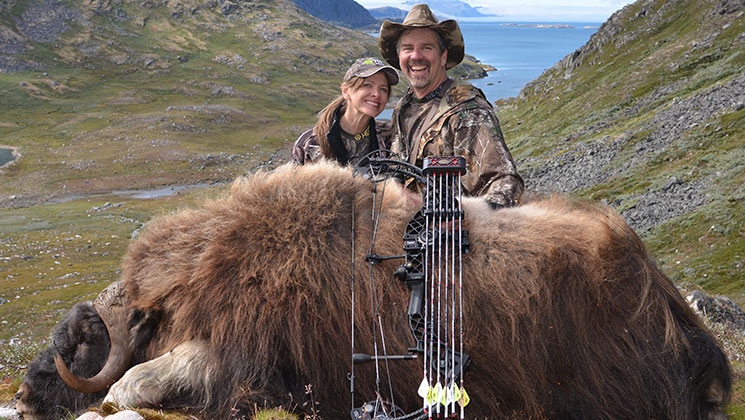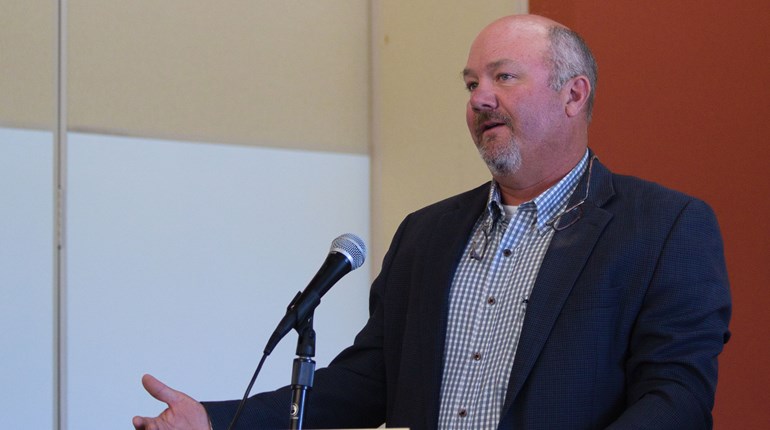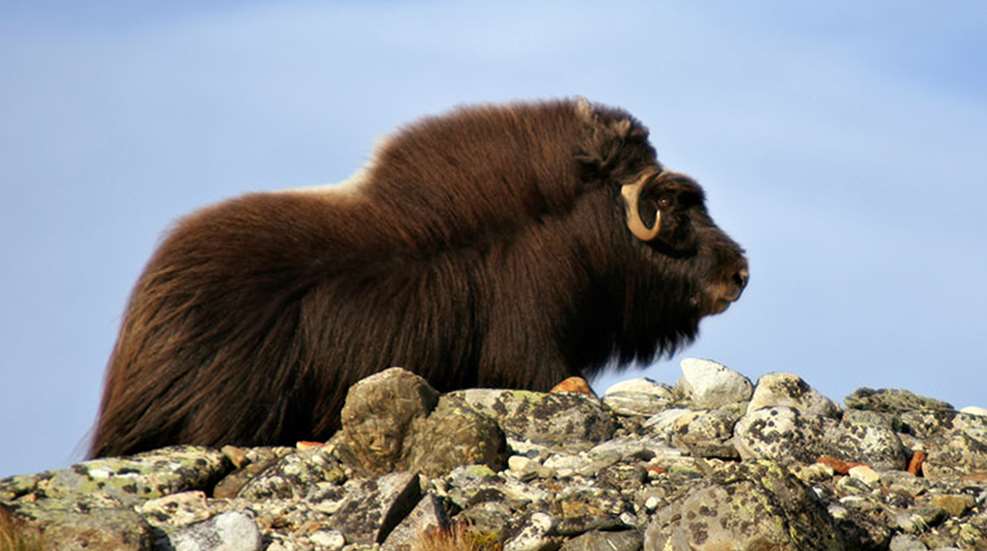
My husband, Phil, and I fell into an opportunity to hunt a remnant of the Ice Age last summer when our friend C.J. Winand called to say he’d just hunted muskox—not in the freezing Canadian Arctic but in Greenland, in 60 degrees in the summer—with outfitter Frank Feldmann. Largely responsible for legalizing bowhunting in Greenland two years earlier, Frank had two spots available last August. I’d sworn off muskox because I refused to chase them in the Arctic at 40 below like Phil had, but this hunt I could do. I’d get story material and Phil would get an adventure episode for “Phil Phillips Unleashed.” The catch? Per Greenland hunting regs, I had three weeks to bump up the draw weight of my bow to 60 pounds.
■■■
You know Greenland’s Polar Ice Sheet when you see it. We stared from the window on the flight from Iceland as the frosty wilderness revealed its true colors: a slab of white mixed with blues and greens, centuries-old ice fragments, ravines with jagged walls that looked like ocean waves, frozen in time, like the muskox. All things considered, Iceland appeared green while Greenland appeared to be the place of ice. We landed in Narsarsuaq in southern Greenland where the local glacier produces 20,000 tons of ice daily.
We grabbed our bags and met Frank and the other hunters, Mike from Pennsylvania and Miguel from Mexico, then overnighted in the Inuit town of Qaqortoq, where brightly painted houses adorned the hillside along the shore.
The next morning we met up with Frank and Rikke (Rick-ee), the outfitter’s assistant and camp cook from Denmark, and boarded Frank’s boat for camp. With no roads between settlements, everyone here relies on boat travel, which means structuring your day by the tides. Through the vinyl cabin windows, I watched our colorful village vanish as we motored along the deep fjord. While the routes were protected from the open sea, the tradeoff was steering in between icebergs that had “chipped off the old block.”
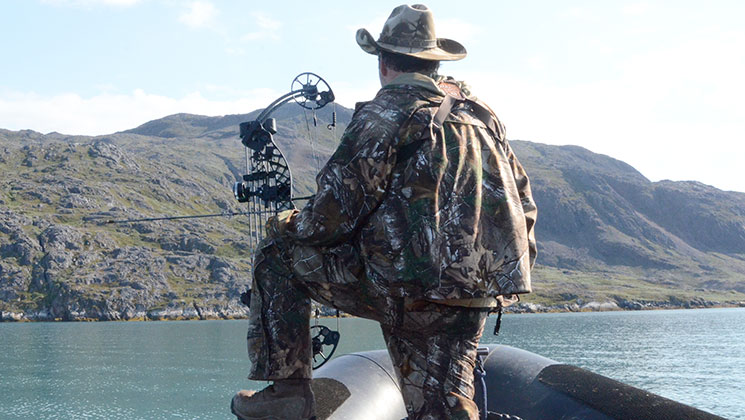
Mesmerized by the distant glacier, I wondered if there was anything prehistoric frozen in that last iceberg we’d passed. Several hours later, I scanned the mountains to my left in time to see caribou tipping over the ridge. The occasional seal popped its head out of the water, but it was a narwhal (the “sea unicorn” with the spiral “tusk”) I’d most hoped to glimpse. An hour later we spotted a shaggy, brown, barrel-shaped animal near the shore—our first muskox.
Camp was a house on a hill overlooking vast tundra and water. As we shot our bows, we learned you can’t get away from mosquitos, even in Greenland. The place reminded me of British Columbia’s coastal areas with gray rock cliffs, mountains rising straight up from the ocean—except there were no trees. Outside of that, it looked like sheep and goat country.
Fittingly, we had muskox for dinner. In between bites, Frank cautioned us that muskox shot placement is tricky. With their hair nearly dragging the ground, it’s easy to shoot too low. The safe bet: Use the top of a bull’s back—smack in the middle of its hump—as a reference point, then drop down 15 to 18 inches. This would not be the walk-up-and-shoot-them-as-they-huddle kind of muskox hunt some hunters have encountered. When in rut, muskox are aggressive and apt to charge. While Frank enjoys toting a bow, he’s required to carry a firearm when guiding.
While Frank guided his muskox hunters one-on-one, spot-and-stalk style, we’d all stay together, partly to help once a bull was down, partly because you never knew how many hunters could fling an arrow by day’s end with so many good bulls in the area. With little to no predation, muskox thrive here.
■■■
Aboard the boat the next morning, Miguel and Mike were up first; Phil and I would hunt the next day. Frank was confident we’d be done in two days then we’d go caribou hunting or fishing. Some Inuits followed us in their own boat, ready to take meat off our hands.
Frank located a “very good bull.” We pulled ashore and three hours and several stalks later, both hunters had great archery trophies. By the time we packed the bulls to the boat it was 4 p.m. While we inhaled the bagged lunches we’d left onboard, I noticed a few muskox at 200 yards, grabbed my camera and headed for the Ice Age remnants. I popped up amongst the rocks, snapping photos, wanting to preserve these intriguing 5-foot-tall herd animals in their natural dignity and grace. I crept to the next rock rise and peered over it. They were fanned out like Indians in old Westerns, staring me down. Both sexes have horns and grizzly-like humps. What if they acted like grizzlies? I slipped back to the boat and we headed for camp.
Everything about this place is frozen in time, I thought, as we motored to an iceberg and chipped off chunks for our cooler. Back in camp we plopped the ice into our drinks and toasted to our success. The popping sounds we heard next were that of air that had been entombed for thousands of years, escaping like genies from bottles. Novelty glacier-ice drinks were all part of the unique hunting experience in a place where the current ice sheet is 110,000 years old. Bars back home would charge a mint for ice from the Great Ice Age, but ice sheets have covered this land for the last 18 million years. Imagine redefining “vintage cocktail” with your own private stash.
Fifteen minutes into our morning boat ride, Frank spotted another “very good bull” up the valley. He, Phil, the cameraman and I would try stalking around it, despite the open setting. We maneuvered and got above it, but with four of us in the open we were busted. The bull trotted up the mountain to join the main herd.
We could have been stone sheep hunting. We went up the mountain, climbing over a boulder slide to get above them. There was much ground to cover and little time to cover it. Frank peeked over the edge and confirmed the animals were there. He knew I preferred not to shoot at a muskox past 40 yards. With the animals moving, it might be a longer shot by the time I was in position.
“Phil, you should take this bull,” I urged, as Frank added, “He’s a good one.” The way it went, it could have been my bull. As Phil looked over the edge, the big bull had stopped to feed—30 yards from our cliff. There was no time to swap places. The muskox farther uphill had already started moving away. Phil took him with one shot. To Frank’s amazement, Phil’s Easton FMJ Injexion tipped with a Grave Digger broadhead with the expandable blades locked down passed through the bull—completely.
“Beautiful bull,” Phil said, as we crouched by its side, admiring its thick boss and its long curved horns with black tips. Its large hooves likely came in handy when breaking through ice to reach water. I loved putting my hands on its qiviut (“kih-vee-ute”), or fur, which nearly dragged the ground, tying the yaks of Asia for sporting the longest hair of any animal.
A stone caught my eye so I grabbed it, noting its iridescent blue-greens and red-browns, a clue about how Earth was formed. I pick up rocks everywhere I hunt; it’s clear Greenland is a budding geologist’s hot spot, home to 225 minerals, 30 of which were discovered here, with 12 so rare they aren’t found anywhere else.
Back onboard, we spotted four more bulls—in the open, impossible to approach. Then Frank spotted another. “He’s good—very big bull,” said the guide. “We have a chance if we go around the herd, cross the creek feeding into the river. We’ll come from behind them through the willows toward shore.”
The sound of the river covered our approach, but in the willows I had no shot. We moved closer. The bull caught movement. Thinking we were another bull approaching, he came out of the brush roaring and stopped, facing us at 25 yards. “He’s a monster,” Frank whispered. Drawing 60 pounds, I had to raise my bow to get to full draw. He realized we weren’t muskox and went back into the willows. I couldn’t believe what just happened. Finally, the herd moved into the open closer to shore. And there stood the bull at 60 yards, in the middle of the cows.
That evening, we shared my story and Frank went on about the size of its horns. And I thought, If I’d gotten Phil’s muskox, Phil easily could have dropped the monster.
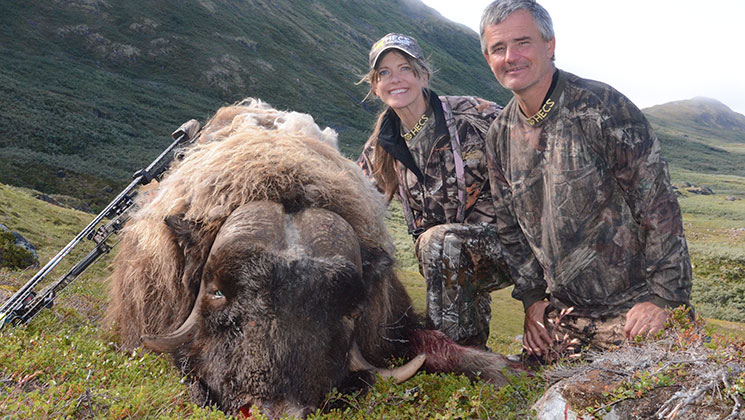
■■■
That bull was gone, but another good one stood in the same spot along the shore the next day. We tried stalking it but couldn’t get in range once all his little friends went on alert. And this bull, too, stood right in the middle.
“We’ll find another bull,” Frank said. We motored on, Frank stopping to evaluate bulls on the hillsides. “Those look like good bulls,” Phil said.
“At least two very good bulls, maybe three,” Frank replied, as we glassed the herd on the steep slope above shore, feeding on a bench with a few stragglers, including one of the bulls, below them. Frank beached the boat and we tiptoed up the slope, stalking the lower bull first. “The other one is bigger,” Frank whispered. “Let’s keep moving.”
We reached the edge below the bench, staying low. There was a faint scent of musk, a lion roar—the bull! He roared again … and again. Frank peered over the top, dropped back down and whispered, “He’s right there. Good bull—30 yards.” I raised my head enough to gauge his position, seeing his head and the top of his body. I had no shot as he stood amongst the cows, roaring. He was easy to keep tabs on because he was starting to shed, piles of puffy underfur showing on his back. He finally stepped out, and I drew and moved up as he walked behind a cow. I let down my bow.
Another roar from the hilltop—another bull. My bull answered the challenge. We peered over the top. “A huge, old bull—even bigger,” Frank said. The dominant, aggressive king of the mountain came down to show who was boss. Obviously outclassed, the first bull headed away with the big bull escorting him out of the herd. Now I had nothing in range.
“Wait, the big one is coming back to the cows,” Phil said. This bull was shedding more and was much bigger than any other bull we’d seen. “Very old trophy—11 or 12,” Frank whispered. The animal caught our movement. Making sure we weren’t an intruding bull, he started walking toward the edge, and us. “If he charges us, run,” said Frank. “My .30-06 may not stop him.” But standing motionless in our HECS suits, the bull looked right through us. Then he pawed the ground and slammed his horns into the dirt, showing his dominance.
He was quartering toward us at 20 yards when the bull on the hillside roared. He turned broadside and responded, and I drew my bow.
The practice with my Mathews Chill SDX paid off. My Easton FMJ tipped with a fixed-blade NAP Hell Razor couldn’t have hit a better spot, burying almost to the fletchings. He ran 15 yards, stopped and dropped. I was amazed how an animal so large could be taken so quickly with a single arrow.
I’d experienced the ultimate, hair-raising muskox hunt, taking out the king as he gave his final performance. I approached the downed monarch, dropping to my knees to touch his face, his fur, to process the history of this fine creature. “You know you made the best shot in camp,” Frank said, smiling. “Phil’s ran 30 yards.” I thanked God, because I knew even Frank was nervous before the shot.
The boss of his horns was massive. I’d noticed one horn was broken, but Frank and I were both surprised to learn both tips were broomed off 5 inches on both sides. Phil knew it but realized this bull was a giant and, like an old bighorn sheep, had knocked off the tips so he could see. Not many muskox get big enough for horn tips to block their vision. (When the taxidermist compared my bull to the six others in the shipment, he said my bull’s skull was a good 25 percent larger, and had he not been broken no doubt would be a Booner.)
Adults weigh 500 to 900 pounds, but Frank and Phil said this one was 900-plus. The soft coat was a mix of black, gray and brown, and I pulled off piles of shedding fur to take home. No wonder muskox are prized for their insulating wool.
Of course, the land keeps you humble as the real work begins. Phil whipped out his Buck knife to help Frank field-dress and skin my bull as everyone helped pack it out. I put the head on my back for a few photos and walked maybe 50 yards before willingly turning it over to someone else. I’d carry another pack, which seemed almost as heavy. The icon of the ages does not pack out lightly.
■■■
The mountain peaks punctured the layer of clouds wafting by—a dividing line between the muskox below and the caribou on high. We’d packed some canisters of O2 Unleashed (O2Unleashed.com) for quick recovery at high elevation, but with Phil still recovering from a back injury after a car accident, we decided to pass on the caribou hunt Frank offered, adding it to the list of reasons to return.
Instead Frank took Phil and me fishing—Inuit style. With Inuit hand lines, a 1-by-4-inch wooden block works like a spool. Drop your line to the bottom, and give it the occasional jerk to attract fish. The contraption has a crank so you can reel the line around the spool once you hook one. It was fun reeling in cod this way. There is no Cabela’s, no Bass Pro Shops up here: I realized how many tools the Inuits have invented to survive. Even wood must be brought here as there are no trees.
Whale, walrus, seal, fish, sometimes muskox—that’s what’s for dinner. Hopefully you know Frank, who can take you fishing, bowfishing or hunting. I thought of the backcountry hunting course I’d just taken, wondering how I’d hold up alone here. We take things for granted when we don’t have to think about them, when food and creature comforts are readily available.
After breakfast, Frank, Phil and I rode to an enormous waterfall; next up, the glacier. I’d read how the top layer of ice melts in summer, leaving air pockets in the ice that make it look white. As we stood on the boat, feeling the chill from the glacier even at 200 yards, I said, “Greenland isn’t all that green, and, at least in this spot, global warming isn’t everything Al Gore says it’s cracked up to be!” I was freezing. It’s normal for ice to break off in summer; the occasional loud crack signifies ice splintering in the distance. Enjoying Mother Nature’s studio, I noted how much easier it is to disconnect from daily life when you’re, well, disconnected. Something spiritual occurs when we connect with nature.
On the last evening, Phil and I walked the shoreline a final time. We climbed atop a rock, stared out at the water and took a selfie. What an amazing adventure we’d had in this land of the muskox covered in white, blue and, of course, green.
